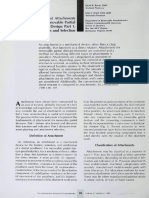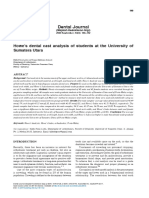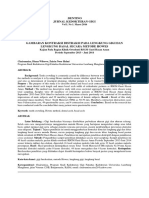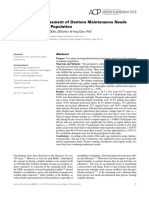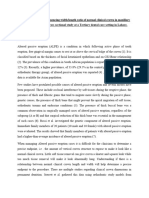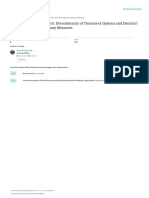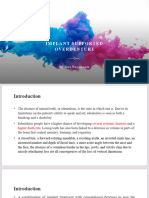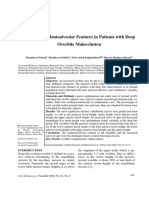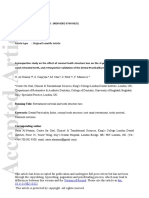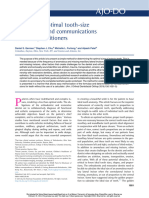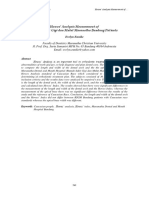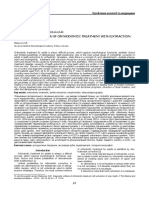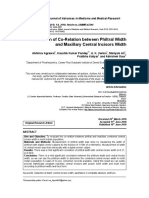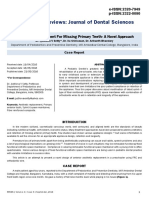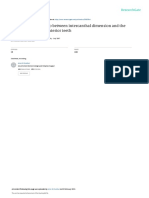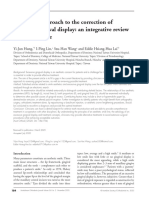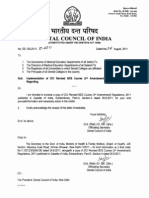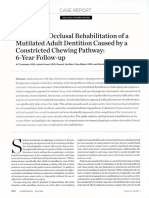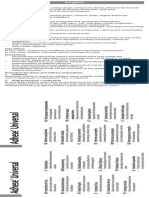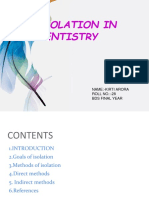Reliability of Intercommissural Width in The Determination of Width of Maxillary Anterior Teeth in Indian and Malaysian Population
Reliability of Intercommissural Width in The Determination of Width of Maxillary Anterior Teeth in Indian and Malaysian Population
Uploaded by
Vi LinhCopyright:
Available Formats
Reliability of Intercommissural Width in The Determination of Width of Maxillary Anterior Teeth in Indian and Malaysian Population
Reliability of Intercommissural Width in The Determination of Width of Maxillary Anterior Teeth in Indian and Malaysian Population
Uploaded by
Vi LinhOriginal Description:
Original Title
Copyright
Available Formats
Share this document
Did you find this document useful?
Is this content inappropriate?
Copyright:
Available Formats
Reliability of Intercommissural Width in The Determination of Width of Maxillary Anterior Teeth in Indian and Malaysian Population
Reliability of Intercommissural Width in The Determination of Width of Maxillary Anterior Teeth in Indian and Malaysian Population
Uploaded by
Vi LinhCopyright:
Available Formats
See discussions, stats, and author profiles for this publication at: https://www.researchgate.
net/publication/325554541
Reliability of intercommissural width in the determination of width of
maxillary anterior teeth in Indian and Malaysian population
Article in Drug Invention Today · April 2018
CITATIONS READS
0 193
2 authors, including:
Ashish R Jain
Tamil Nadu Dr. M.G.R. Medical University
209 PUBLICATIONS 609 CITATIONS
SEE PROFILE
All content following this page was uploaded by Ashish R Jain on 20 June 2018.
The user has requested enhancement of the downloaded file.
Research Article
Reliability of intercommissural width in the determination
of width of maxillary anterior teeth in Indian and
Malaysian population
J. Lakshmi Prabha, Ashish R. Jain*
ABSTRACT
Aim: The aim of this article was to assess the reliability of intercanine distance and intercommissural width in determining
the width of maxillary anterior teeth in Indian and Malaysian populations. Materials and Methods: The study included
39 dentate subjects with Angles Class I molar and canine relationships. The patients who visited a private dental college
were selected for this study, and an informed consent was obtained from these patients who were included in this study.
The exclusion criteria for this study were patients with malocclusions, those who have undergone orthodontic treatments,
periodontally compromised patients, missing teeth, or any gross skeletal or facial deformities. The intercommissural width
was measured in mm with the patient seated on dental chair in a relaxed posture with a divider and scale. The intercanine
distance was measured in mm using stone models poured with a non-elastic thread and scale. Results: This study showed
that the mean value for intercanine width (55.4 mm and 54.3 mm) and intercommissural width (53.4 mm and 55.4 mm) for
Indian and Malaysian populations, respectively, was determined and was found to be comparatively equal. The Pearson’s
coefficient index “r” was calculated which showed a positive correlation between the two parameters in both the populations.
The r value for intercanine distance and intercommissural width for Indian and Malaysian population was found to be 0.8514
and 0.8136, respectively. Conclusion: Anterior teeth selection plays a major role in the fabrication of complete denture. The
major difficulty lies in the selection of anterior teeth when pre-extraction records are not available. Hence, this study was
done to emphasize the importance of intercommissural width in the determination of width of anterior teeth.
KEY WORDS: Anterior teeth selection, Intercanine distance, Intercommissural width, Maxillary teeth
INTRODUCTION and extracted teeth. A major hurdle in achieving a
pleasing esthetic smile is the selection of anterior teeth
Replacement of missing teeth is of major concern in the absence of pre-extraction records.[2] In this case,
to restore esthetics and function. In case of a various other parameters such as bizygomatic width,
completely edentulous patient, complete denture is interpupillary distance, interalar width, intercanthal
essential to prevent atrophy of muscles and to help distance, and intercommissural width were used for a
in mastication.[1] Fabrication of complete denture systematic approach of anterior teeth selection.[1,3] To
depends on various parameters which determine achieve functional and physical rehabilitation of the
its success. One such parameter is anterior teeth patient, the proper choice objective parameter should
selection which plays a major role in determining be established. This helps in reconstructing an optimal
the esthetics. Dentists use various parameters and occlusion for the edentulous patient.[4]
indicators for anterior teeth selection in day-to-day
Smile design and anterior teeth selection of artificial
practice. Pre-extraction records which help in anterior
teeth are of key importance in producing proper
teeth selection for edentulous patients include pre- occlusal reconstruction in the prosthetic management
extraction photographs, radiographs, stone models, of edentulous patients.[4] In most cases, the chief
complaint of the patient remains specifically anterior
Access this article online tooth esthetics which is primarily based on the width
Website: jprsolutions.info ISSN: 0975-7619
of central incisors and anatomical variations of
this cause unpleasing appearance.[1] Anterior teeth
Department of Prosthodontics, Saveetha dental college, Saveetha University, Chennai, Tamil Nadu, India
*Corresponding author: Dr. Ashish R. Jain, Department of Prosthodontics, Saveetha Dental College and Hospital,
Saveetha University, Ponamalle High Road, Chennai – 600 127, Tamil Nadu, India. Phone:+91-9884233423.
E-mail: dr.ashishjain_r@yahoo.com
Received on: 18-02-2017; Revised on: 26-03-2018; Accepted on: 28-04-2018
506 Drug Invention Today | Vol 10 • Issue 4 • 2018
J. Lakshmi Prabha and Ashish R. Jain
selection depends on teeth visibility, positive incisal anterior teeth was selected by dividing transverse
line, and size and color which helps in physiognomic. circumference of the head by 13 or by dividing the
They help in restoring functional and physical bizygomatic width by 3.3. According to Sears study,
rehabilitation to the edentulous patients. Factors tooth length was compared to the length of the
which help in teeth selection are patients’ age, gender, face.[9,12] Hence, it is concluded by various researchers
facial type, and harmony between size, shape, and that anthropometric analysis done within similar
color of the teeth.[4] Teeth size is determined based population groups and their interrelationship with
on the “Golden Proportion” which is universally the natural teeth measurements using pre-extraction
excepted proportion of incisal and canine widths first records help in better determination of anterior teeth
proposed by “Lombardi.” However, several studies selection for edentulous patients.[4,9]
have stated that the esthetic smiles are not designed
using this golden proportion, and hence, this topic Various studies report variations in the result based
remains controversial.[4,5] Hence, to achieve esthetic on various characteristics and ethnicity. Thus, this
outcome and patient acceptance, there has to be an study was aimed at determining the reliability of the
understanding between the physical and biological width of Intermaxillary commissure in comparison to
factors which are directly related to the patient’s intercanine width for anterior teeth selection in two
individual features.[1] different populations.
Several studies have been done to estimate and MATERIALS AND METHODS
correlate the use of various extraoral and intraoral
landmarks to determine the anterior teeth in In this study, 39 dentate subjects were selected from
edentulous patients. This study was conducted based a private dental institution, of which 25 subjects were
on the hypothesis that intercanine distance is used Indians and the rest 14 subjects were Malaysians.
for the measurement of anterior teeth as the distal The inclusion criteria included subjects interested
surfaces of the canines are seen to correspond to the in participating in the study, patients above 18 years
commissures of the mouth. A study by Silverman of age for whom the growth phase is completed,
showed that intercanine was ± 4 mm from the and patients with complete arch without orthodontic
commissures, but another study showed that there findings and good periodontal health.[1] Exclusion
was no significant correlation between intercanine criteria included history of orthodontic treatment, gross
distance and intercommissural width in anterior teeth facial asymmetry, signs of inflammation, congenital
selection.[3,6,7] Another study by Baer and Reynold or surgical defects or any conservative restorations,
showed that the patients prefer the lesser width of paediatric patients, and patients with growth
artificial teeth in prosthesis when compared to the deformities. An informed consent was obtained from
width of their natural teeth.[8] However, there are the participants of this study.[2,4,9] The two parameters
little data in literature stating the accurate guidelines compared in this study were intercanine distance and
for anterior teeth selection. This shows that more intercommissural width.[3]
than one parameter should be assessed for accurate
prediction of the width of anterior teeth in determining This study was designed to evaluate the use and
teeth selection.[4] Certain authors believe the use of accuracy of intercanine width and intercommissural
facial measurements provides better accuracy in width in the selection of anterior teeth. The
teeth selection. These measurements are made with intercommissural width was measured extra orally with
the help of easily located constant reference points the patient’s mouth in the rest position [Figure 2]. The
usually facial landmarks and are compared with the patient was made to sit comfortably in the dental chair
width of anterior teeth. These measurements are in erect posture. Phonetics method was used to keep
seen to be similar in same population groups and are the patients’ mouth relaxed and in the rest position.
seen to show varied results across foreign population The intercommissural width was measured using a
groups.(3) “Biometric ratio method” devised by divider and scale, and the values were tabulated. The
Berry stated that dimensions of central incisors were intercanine width was measured on stone casts made
found to be one-sixteenth of the face width and one- from irreversible hydrocolloid impression material
twentieth of the face length.[9,10] House and Loop taken in stock trays. The casts were then trimmed, and
stated in their study the relation between width of the inter canine width was measured using a non-elastic
maxillary central incisor and bizygomatic width as thread measuring from the distal end of one canine to
one-sixteenth of greatest bizygomatic width equal the distal end of another canine [Figure 1]. The thread
to the width of maxillary central incisors. It was also was fixed to the smooth and highest circumference of
found that this value when divided by 3.3 gives the the cast, and the markings were made on both sides
maximum dimension of the overall width of anterior of the distal margin of canine. The distance between
teeth in maxilla.[9,11] Sears proposed a similar method the thread marks was measured using a scale, and the
using “Anthropometric Cephalic Index” in which readings were tabulated.[3,9]
Drug Invention Today | Vol 10 • Issue 4 • 2018 507
J. Lakshmi Prabha and Ashish R. Jain
Both the parameters were measured 3 times, and teeth selection over conventional technique of using
the average value was considered for the study. All intercanine distance [Graphs 3 and 4].[2,3]
the data recorded were compiled and entered in a
spreadsheet using Microsoft Excel software, and the DISCUSSION
coefficient value was calculated using a “r” value
calculator. The value of coefficient of determination It is scientifically proven that there is no reliable
“r2” was also determined, and the readings were method of accurately assessing the selection of anterior
tabulated.[3,4,9] teeth in the absence of pre-extraction records. There is
increased difficulty in teeth selection for edentulous
RESULTS patients in case of absence of these records. Hence,
discussions on this are based on various studies and
The readings were tabulated and the mean was taken reviews conducted to assess the reliability of different
as shown in tabulation Table 1 and Graph 1. The mean parameters used for teeth selections using different
value for intercanine width (55.4 mm and 54.3 mm) methodology.[4,13]
and intercommissural width (53.4 mm and 55.4 mm)
for Indian and Malaysian populations, respectively, This study is done to present the reliability of one
was determined and was found to be comparatively such parameter, namely, the intercommissural width
equal. Then, the Pearson’s coefficient index “r” was in assessing the anterior teeth selection in comparison
calculated to determine the correlation between the
intercanine distance and intercommissural width of
both Indian and Malaysian populations, respectively,
and the Graph 2 was plotted. The value of r was found
to be 0.8514 and 0.8136 for intercanine distance and
intercommissural width, respectively. This showed
that there is a positive correlation between intercanine
distance and intercommissural width in anterior
teeth selection and is reliable across both races. The
coefficient of determination “r2” was 0.7249 and
0.6619 for intercanine distance and intercommissural
width, respectively. These data were analyzed and
compared with the previous studies to check the
reliability of intercommissural width in anterior
Graph 3: X and Y values for Indian population
Graph 1: Mean values of Indian population
Graph 2: Mean values of Malaysian population Graph 4: X and Y values for Malaysian population
508 Drug Invention Today | Vol 10 • Issue 4 • 2018
J. Lakshmi Prabha and Ashish R. Jain
Table 1: Mean values and r values for Indian and Malaysian populations
Parameter n Sum of X values Sum of Y values Mean of X Mean of Y r values r2
(intercanine distance) (intercommissural width) values values values
Indian 25 1386 1335 55.4 53.4 0.8514 0.7249
population
Malaysian 14 760 776 54.3 55.4 0.8136 0.6619
population
in measurements of intercanine width due to wear and
inability to maintain the same arc of greatest curvature
around the maxillary cast used for the measurement of
intercanine distance.[1,16] Since the correlation between
the parameters were weak in their study, it proved that
no single parameter can be a reliable measurement for
anterior teeth selection and it also made emphasizes on
the use of pre-extraction records for teeth selection.[1] A
study by Glynis and Mariette suggested measurement
of intercanine width as a straight line measurement to
avoid errors caused by proclination or retroclination
Figure 1: Measurement of intercanine distance or the level of circumferential measurement.[2] This
study states linear measurement as a reliable method
which is in accordance with the study by Ahn et al.[2,17]
Deogade et al. in their study stated that variations
in the values may occur due to different measuring
techniques used and the various population groups
involved in the study. This study also showed a strong
positive correlation between the parameters which is
in accordance with the present study.[3,18]
With the small number of subjects analyzed in this
study, efforts to standardize the measurements were
made. However, still the question of a generalized
method which can be used for anterior teeth selection
persists.[9] The main limitations of this study are
that it does not assess gender-based variations and
includes only two population groups. Thus, the future
prospective of the study is that it has to be carried out
Figure 2: Measurement of intercommissural width
across other population groups and subgroups with an
increase in sample size.
to the conventional intercanine distance. The study CONCLUSION
showed a strong positive correlation between the
two parameters which emphasizes the fact that in the Anterior teeth selection plays a major role in the
absence of pre-extraction records, and anterior teeth fabrication of complete denture.[19] The major
selection can be done using intercommissural width of difficulty lies in the selection of anterior teeth when
the patient at rest. This is in accordance with the study pre-extraction records are not available.[20] It is
conducted by Waseemand Raisa in estimating the concluded from this study that the intercommissural
dimensions of anterior teeth in Kashmiri population. width is a reliable parameter in anterior teeth selection
Although there was a weak but significant correlation records are unavailable or intercanine width cannot
between the intercommissural width and anterior teeth be determined.[21] Hence, this study was done to
dimensions which is contradictory to this study results, emphasize the importance of intercommissural width
there is a strong positive correlation between the in the determination of width of anterior teeth within
parameters.[9] However, the study conducted by Kini certain limitations which can be reevaluated in the
and Angadi showed similar results with this study and future studies. However, this study was conducted in
established a significant positive correlation between a smaller population, and within only two races, it can
the parameters.[9,14] Ellakwa et al. stated the importance be further investigated in a larger population across
of intercanine width for anterior teeth selection in their different population groups and subgroups for better
study.[1,15] Their results showed variability and difficulty knowledge.
Drug Invention Today | Vol 10 • Issue 4 • 2018 509
J. Lakshmi Prabha and Ashish R. Jain
REFERENCES Whittier (CA): MM House; 1939. p. 3-33.
12. Sears VH. Selection of anterior teeth for artificial dentures. J
1. Ellakwa A, McNamara K, Sandhu J, James K, Arora A, Am Dent Assoc 1941;28:928-35.
Klineberg I, et al. Quantifying the selection of maxillary 13. Zlatarić DK, Kristek E, Celebić A. Analysis of width/length
anterior teeth using intraoral and extraoral anatomical ratios of normal clinical crowns of the maxillary anterior
landmarks. J Contemp Dent Pract 2011;12:414-21. dentition: Correlation between dental proportions and facial
2. Miranda GA, D’Souza M. Evaluating the reliability of the measurements. Int J Prosthodont 2007;20:313-5.
interalar width and intercommissural width as guides in 14. Kini AY, Angadi GS. Biometric ratio in estimating widths of
selection of artificial maxillary anterior teeth: A clinical study. J maxillary anterior teeth derived after correlating anthropometric
Interdiscip Dent 2016;6:2:64-70. measurements with dental measurements. Gerodontology
3. Deogade SC, Mantri SS, Sumathi K, Rajoriya S. The relationship 2013;30:105-11.
between innercanthal dimension and interalar width to the 15. Scandrett F, Kerber PE, Umrigar ZR. A clinical evaluation of
intercanine width of maxillary anterior teeth in central Indian techniques to determine the combined width of the maxillary
population. J Indian Prosthodont Soc 2015;15:91-7. anterior teeth and the maxillary central incisor. J Prosthet Dent
4. Strajnić L, Vuletić I, Vucinić P. The significance of biometric 1982;48:15-22.
parameters in determining anterior teeth width. Vojnosanit 16. Chu JS. Range and mean distribution frequency of individual
Pregl 2013;70:653-9. tooth width of the maxillary anterior dentition. Pract Proced
5. Lombardi RE. The principles of visual perception and their Aesthet Dent 2007;19:209-15.
clinical application to denture esthetics. J Prosthet Dent 17. Ahn HJ, Yang HS, Park HO. A study on the selection of the
1973;29:358-82. maxillary anterior artificial teeth in Korean adults. J Korean
6. Al Wazzan KA, Al Haidan A, Al Madi EM, Al Murfarj A. The Acad Prosthodont 2002;40:484‑92.
relationship between facial references and mesiodistal width 18. Sellen PN, Jagger DC, Harrison A. Methods used to select
of maxillary anterior teeth among Saudi patients. Alex Dent J artificial anterior teeth for the edentulous patient: A historical
1995;20:39‑45. overview. Int J Prosthodont 1999;12:51‑8.
7. Silverman SI. Physiologic factors in complete denture esthetics. 19. Wehner P, Hickey C, Boucher D. Selection of artificial teeth.
Dent Clin North Am 1967;3:115-22. J Pros Dent 1967;18:222-32.
8. Baer ML, Reynolds MA. Comparison of anterior tooth width in 20. Ward DH. A study of dentists’ preferred maxillary anterior
natural and artificial dentitions. J Prosthodon 1992;1:84-7. tooth width proportions: Comparing the recurring esthetic
9. Ayoub W, Rashid R. Evaluation of the current techniques and dental proportion to other mathematical and naturally occurring
introduction of a novel approach for estimating maxillary proportions. J Esthet Restor Dent 2007;19:324-14.
anterior teeth dimensions in Kashmiri population. Int J Appl 21. Landa LS. Practical guidelines for complete denture esthetics.
Dent Sci 2017;3:26-31. Dent Clin North Am 1977;21:285‑98.
10. Berry F. Is the theory of temperaments the foundation of the
study of prosthetic art. Dent Mag 1905;1:405-13.
11. House M, Loop J. Form Andcolor in Dental Art (Monograph).
Source of support: Nil; Conflict of interest: None Declared
510 Drug Invention Today | Vol 10 • Issue 4 • 2018
View publication stats
You might also like
- Burns 1990 A Review of Attachments For Removable Partial Denture Design Part 1. Classification and SelectionDocument6 pagesBurns 1990 A Review of Attachments For Removable Partial Denture Design Part 1. Classification and SelectionKenigal14No ratings yet
- Injection Overmolding For Aesthetics and Strength Part 1Document4 pagesInjection Overmolding For Aesthetics and Strength Part 1The Bioclear ClinicNo ratings yet
- Force Acting On Restoration / Orthodontic Courses by Indian Dental AcademyDocument59 pagesForce Acting On Restoration / Orthodontic Courses by Indian Dental Academyindian dental academy100% (12)
- 279Document8 pages279ASHISH R JAINNo ratings yet
- Dental Journal: Howe's Dental Cast Analysis of Students at The University of Sumatera UtaraDocument4 pagesDental Journal: Howe's Dental Cast Analysis of Students at The University of Sumatera UtaraYasin TopcuNo ratings yet
- Complete DentureDocument4 pagesComplete Denturepopat78100% (1)
- 09 Ijss Sep Oa09 2015 PDFDocument5 pages09 Ijss Sep Oa09 2015 PDFIonela MadalinaNo ratings yet
- Morphological Characteristics of Primary Dentition in Children of Chennai and HyderabadDocument9 pagesMorphological Characteristics of Primary Dentition in Children of Chennai and HyderabadSarmad AlwardiNo ratings yet
- Filure EndoDocument10 pagesFilure EndoDimitar KosturkovNo ratings yet
- The Effect of Premolar Discrepancy Extractions On Tooth-SizeDocument7 pagesThe Effect of Premolar Discrepancy Extractions On Tooth-SizeKanish AggarwalNo ratings yet
- Selection and Arrangement of Teeth For Esthetic Complete Denture Prosthesis - An Art and ScienceDocument10 pagesSelection and Arrangement of Teeth For Esthetic Complete Denture Prosthesis - An Art and ScienceShreyakalyani PanikkerNo ratings yet
- Clinical Evaluation of Failures in Removable Partial DenturesDocument6 pagesClinical Evaluation of Failures in Removable Partial DenturesAlina AlexandraNo ratings yet
- Dentino Jurnal Kedokteran Gigi: - Juni 2014Document6 pagesDentino Jurnal Kedokteran Gigi: - Juni 2014maria yopitaNo ratings yet
- 1clinical Evaluation of Failures of Removable Partial Dentures PDFDocument7 pages1clinical Evaluation of Failures of Removable Partial Dentures PDFcsmalxNo ratings yet
- Pattern and Causes of Tooth Extraction in Patients Reporting To A Teaching Dental HospitalDocument6 pagesPattern and Causes of Tooth Extraction in Patients Reporting To A Teaching Dental HospitalAnye PutriNo ratings yet
- Longitudinal Assessment of Denture Maintenance NeedsDocument8 pagesLongitudinal Assessment of Denture Maintenance Needshafidh akbarNo ratings yet
- 1447-Article Text-2819-1-10-20201203Document9 pages1447-Article Text-2819-1-10-20201203Julieta JouannyNo ratings yet
- IMPLANTOLOGÍA. Tarnow When To Save or Extract A Tooth in The Esthetic Zone A CommentaryDocument12 pagesIMPLANTOLOGÍA. Tarnow When To Save or Extract A Tooth in The Esthetic Zone A CommentaryKenigal14No ratings yet
- Crown Ratio SynopsisDocument8 pagesCrown Ratio Synopsismuhammadsyed596No ratings yet
- Case Selection in Dental Implant TherapyDocument4 pagesCase Selection in Dental Implant Therapymichealraj rousseauNo ratings yet
- Prevalence of Anterior Strip Crowns Among Carious Primary TeethDocument6 pagesPrevalence of Anterior Strip Crowns Among Carious Primary TeethNabila RizkikaNo ratings yet
- Analysis of The Gingival Biotype Based On The Measurement of The Dentopapillary ComplexDocument6 pagesAnalysis of The Gingival Biotype Based On The Measurement of The Dentopapillary ComplexAngela ArrazolaNo ratings yet
- Evaluation of Conformity of Preformed Orthodontic Archwires and Dental Arch FormDocument9 pagesEvaluation of Conformity of Preformed Orthodontic Archwires and Dental Arch Formyerly ramirezNo ratings yet
- Retention of Teeth Versus Extraction and Implant Placement: Treatment Preferences of Dental Faculty and Dental StudentsDocument7 pagesRetention of Teeth Versus Extraction and Implant Placement: Treatment Preferences of Dental Faculty and Dental StudentsShyam K MaharjanNo ratings yet
- Sardarian2018 PDFDocument7 pagesSardarian2018 PDFZero's BusinessNo ratings yet
- GenderDocument6 pagesGenderPaula Andrea Vargas MarinNo ratings yet
- Evaluation of Brushing Techniques TaughtDocument5 pagesEvaluation of Brushing Techniques TaughtJavier Cabanillas ArteagaNo ratings yet
- JCDPDocument9 pagesJCDPSyed Mohammad Osama AhsanNo ratings yet
- Discolored Non-Vital Teeth: Determinants of Treatment Options and Dentists' Knowledge of Precautionary MeasuresDocument8 pagesDiscolored Non-Vital Teeth: Determinants of Treatment Options and Dentists' Knowledge of Precautionary MeasuresIQRAINI BALQISNo ratings yet
- ISODDocument20 pagesISODsawa.ameenNo ratings yet
- NEW BUSHRA FinalDocument22 pagesNEW BUSHRA Finalmudassir rehman100% (1)
- Asian Journal of Oral and Maxillofacial SurgeryDocument7 pagesAsian Journal of Oral and Maxillofacial SurgeryMichaelAndreasNo ratings yet
- Evaluation of Golden Proportion Between Maxillary Anterior Teeth of South Indian Population DOJ 2 125Document5 pagesEvaluation of Golden Proportion Between Maxillary Anterior Teeth of South Indian Population DOJ 2 125Ritesh SinglaNo ratings yet
- Tooth Wear in Aging People - An Investigation of The Prevalence and The Influential Factors of Incisal - Occlusal Tooth Wear in Northwest ChinaDocument6 pagesTooth Wear in Aging People - An Investigation of The Prevalence and The Influential Factors of Incisal - Occlusal Tooth Wear in Northwest ChinaIgnacio PerloNo ratings yet
- Literature Review On Dental ProblemsDocument4 pagesLiterature Review On Dental Problemsd0vidihujam3100% (1)
- Panoramica IndigenasDocument5 pagesPanoramica IndigenasJoel RojasNo ratings yet
- Skeletal and Dentoalveolar Features in Patients With Deep Overbite MalocclusionDocument11 pagesSkeletal and Dentoalveolar Features in Patients With Deep Overbite MalocclusionAstrid Carolina HerreraNo ratings yet
- Aulakh 2016Document20 pagesAulakh 2016henriquetaranNo ratings yet
- Coelho de Souza2015Document20 pagesCoelho de Souza2015kelly johanna quintero arevaloNo ratings yet
- Plaque Index in Multi-Bracket Fixed Appliances: Original ArticleDocument5 pagesPlaque Index in Multi-Bracket Fixed Appliances: Original ArticleKIH 20162017No ratings yet
- 1.1 Original ResearchDocument8 pages1.1 Original ResearchNovita RNo ratings yet
- Zade RM: Shaju Jacob PDocument4 pagesZade RM: Shaju Jacob Pakash_81087No ratings yet
- Forensic Odontology A Review.20141212073749Document8 pagesForensic Odontology A Review.20141212073749Apri DhaliwalNo ratings yet
- Relationship Between Maxillary and Mandibular Base Lengths in Class II Malocclusions in Patients Visiting Tertiary Care HospitalDocument8 pagesRelationship Between Maxillary and Mandibular Base Lengths in Class II Malocclusions in Patients Visiting Tertiary Care HospitalRehana RamzanNo ratings yet
- Tooth-Implant Supported RemovableDocument29 pagesTooth-Implant Supported RemovabletaniaNo ratings yet
- Extraction of Primary Teeth in Children: An Observational StudyDocument6 pagesExtraction of Primary Teeth in Children: An Observational StudyhayiarNo ratings yet
- De Sousa APBR - in Vitro Tooth Reattachment Technique PDFDocument23 pagesDe Sousa APBR - in Vitro Tooth Reattachment Technique PDFPatricia JesikaNo ratings yet
- Version of Record Doi: 10.1111/IEJ.13322: A, B A A A, C ADocument23 pagesVersion of Record Doi: 10.1111/IEJ.13322: A, B A A A, C AShriya ShahuNo ratings yet
- Simplifying Optimal Tooth-Size Calculations and Communications Between PractitionersDocument5 pagesSimplifying Optimal Tooth-Size Calculations and Communications Between PractitionersmaiNo ratings yet
- Restoring Dentate AppearanceDocument22 pagesRestoring Dentate AppearanceJittin JamesNo ratings yet
- Jap 4 109Document7 pagesJap 4 109Buzatu IonelNo ratings yet
- Journal Homepage: - : Manuscript HistoryDocument8 pagesJournal Homepage: - : Manuscript HistoryIJAR JOURNALNo ratings yet
- Howes Analysis Measurement of Rumah Sakit Gigi Da PDFDocument8 pagesHowes Analysis Measurement of Rumah Sakit Gigi Da PDFghinaNo ratings yet
- Howes Analysis Measurement of Rumah Sakit Gigi Da PDFDocument8 pagesHowes Analysis Measurement of Rumah Sakit Gigi Da PDFghinaNo ratings yet
- Original ArticleDocument7 pagesOriginal ArticleJavier Farias VeraNo ratings yet
- Makarova О.М.: Ukrainian Medical Stomatological Academy, Poltava, UkraineDocument4 pagesMakarova О.М.: Ukrainian Medical Stomatological Academy, Poltava, UkrainepaolaNo ratings yet
- Bone Resorption Comparison in Bridge Side and Non-Bridge Side On OPGDocument72 pagesBone Resorption Comparison in Bridge Side and Non-Bridge Side On OPGBzhar1994 MuhammedNo ratings yet
- 19abhinav Thesis Article 1Document6 pages19abhinav Thesis Article 1bhupendraNo ratings yet
- Full Mouth Rehabilitation of Adult Rampant Caries With Pragmatic ApproachDocument6 pagesFull Mouth Rehabilitation of Adult Rampant Caries With Pragmatic ApproachNur Muhammad GhifariNo ratings yet
- Comparing Oral Care of Dental and Engineering StudentsDocument7 pagesComparing Oral Care of Dental and Engineering StudentsInternational Journal of Innovative Science and Research TechnologyNo ratings yet
- Comprehensive Prosthodontic and Orthodontic Rehabilitation of Fractured Upper Anteriors Due To Accidental Trauma - Aninterdisciplinary ApproachDocument7 pagesComprehensive Prosthodontic and Orthodontic Rehabilitation of Fractured Upper Anteriors Due To Accidental Trauma - Aninterdisciplinary ApproachIJAR JOURNALNo ratings yet
- Aesthetic Replacement For Missing Primary Teeth A Novel ApproachDocument3 pagesAesthetic Replacement For Missing Primary Teeth A Novel ApproachAaser AhmedNo ratings yet
- Hatice ÖzdemirDocument7 pagesHatice ÖzdemirVi LinhNo ratings yet
- ULHASDocument6 pagesULHASVi LinhNo ratings yet
- Comparison of Maxillary Anterior Tooth Width and Facial Dimensions of 3 EthnicitiesDocument8 pagesComparison of Maxillary Anterior Tooth Width and Facial Dimensions of 3 EthnicitiesVi LinhNo ratings yet
- Krishan KumarDocument7 pagesKrishan KumarVi LinhNo ratings yet
- 10.21307 - Aoj 2020 021Document11 pages10.21307 - Aoj 2020 021Saumya SinghNo ratings yet
- Electric Toothbrush 2Document3 pagesElectric Toothbrush 2Rian Lee TiangcoNo ratings yet
- Three Dimensional Position of Impacted Maxillary Canines - Prevalence, Associated Pathology and Introduction To A New Classification SystemDocument7 pagesThree Dimensional Position of Impacted Maxillary Canines - Prevalence, Associated Pathology and Introduction To A New Classification SystemDalia Zamora GarciaNo ratings yet
- Script ForDocument4 pagesScript Forqwerty123No ratings yet
- Correction of A Full Cusp Class II Malocclusion and Palatal Impingement With Intermaxillary ElasticsDocument19 pagesCorrection of A Full Cusp Class II Malocclusion and Palatal Impingement With Intermaxillary Elasticssandhi triutomoNo ratings yet
- B-2211 Implementation of DCI Revised B.D.S. CourseDocument17 pagesB-2211 Implementation of DCI Revised B.D.S. CourseShital KiranNo ratings yet
- Lecture 3 - Fixed and Removable AppliancesDocument114 pagesLecture 3 - Fixed and Removable AppliancesYasser ObaidNo ratings yet
- Functional Occlusal Rehabilitation of A Mutilated Adult Dentition Caused by A Constricted Chewing PathwayDocument9 pagesFunctional Occlusal Rehabilitation of A Mutilated Adult Dentition Caused by A Constricted Chewing Pathwayjorefe12No ratings yet
- The Importance of Glide Path Preparation in Endodontics: A Consideration of Instruments and LiteratureDocument6 pagesThe Importance of Glide Path Preparation in Endodontics: A Consideration of Instruments and LiteratureMirza FirnandaNo ratings yet
- Pregnancy BrochureDocument2 pagesPregnancy Brochureapi-464628523No ratings yet
- Dissertation On Finite Element Analysis in OrthodonticsDocument7 pagesDissertation On Finite Element Analysis in OrthodonticsPaperHelpWritingCanadaNo ratings yet
- Perio PocketDocument6 pagesPerio PocketManoj Kn100% (1)
- Comparison of The Marginal Fit of Various Ceramic Crown SystemsDocument5 pagesComparison of The Marginal Fit of Various Ceramic Crown SystemsrojNo ratings yet
- Dental BiochemistryDocument17 pagesDental BiochemistryBokiNo ratings yet
- Articulators in FPDDocument55 pagesArticulators in FPDMamata DugarajuNo ratings yet
- Jaw MaxxingDocument7 pagesJaw MaxxingaquamaxgamingNo ratings yet
- Adhese UniversalDocument48 pagesAdhese UniversalAdina SerbanNo ratings yet
- Borrie2011 Early Correction of Anterior Crossbites - A Systematic ReviewDocument10 pagesBorrie2011 Early Correction of Anterior Crossbites - A Systematic Reviewwidhariyani purnomoputriNo ratings yet
- Johnson Samantha HLTH 3420 Teaching Plan Template 1Document7 pagesJohnson Samantha HLTH 3420 Teaching Plan Template 1api-329945753No ratings yet
- Paskay JAOSm-A12 Prf1Document8 pagesPaskay JAOSm-A12 Prf1cintaNo ratings yet
- 16 03 BuccalCanineJCD-15-18 PDFDocument5 pages16 03 BuccalCanineJCD-15-18 PDFRebin AliNo ratings yet
- Digital DentistryDocument401 pagesDigital Dentistryvc100% (1)
- Epidemiology of Periodontal DiseasesDocument54 pagesEpidemiology of Periodontal DiseasesAmira RadwanNo ratings yet
- ISOLATION FinlaiDocument60 pagesISOLATION Finlaikirti arora100% (2)
- Omergorduysus 2001Document4 pagesOmergorduysus 2001Himasai Reddy Vanga100% (1)
- Early Treatment of Class III Malocclusion: Is It Worth The Burden?Document4 pagesEarly Treatment of Class III Malocclusion: Is It Worth The Burden?gisela100% (1)
- Dental and Skeletal Characteristics of Individuals With Normal, Class Ii and Class Iii Occulsions - A Cephalometric Evaluation Using Tetragon AnalysisDocument9 pagesDental and Skeletal Characteristics of Individuals With Normal, Class Ii and Class Iii Occulsions - A Cephalometric Evaluation Using Tetragon AnalysisFernando Caro PinillaNo ratings yet
